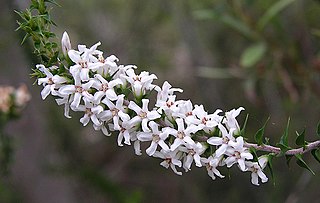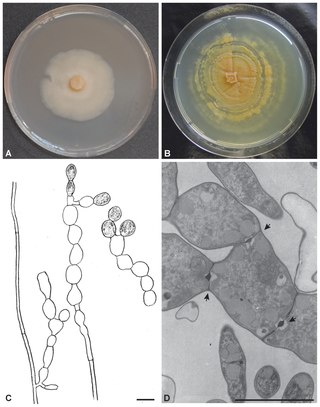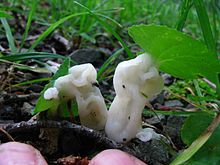
Botany, also called plant science, plant biology or phytology, is the science of plant life and a branch of biology. A botanist, plant scientist or phytologist is a scientist who specialises in this field. The term "botany" comes from the Ancient Greek word βοτάνη meaning "pasture", "herbs" "grass", or "fodder"; βοτάνη is in turn derived from βόσκειν, "to feed" or "to graze". Traditionally, botany has also included the study of fungi and algae by mycologists and phycologists respectively, with the study of these three groups of organisms remaining within the sphere of interest of the International Botanical Congress. Nowadays, botanists study approximately 410,000 species of land plants of which some 391,000 species are vascular plants, and approximately 20,000 are bryophytes.

Led Zeppelin were an English rock band formed in London in 1968. The group comprised vocalist Robert Plant, guitarist Jimmy Page, bassist and keyboardist John Paul Jones, and drummer John Bonham. With a heavy, guitar-driven sound, they are cited as one of the progenitors of hard rock and heavy metal, although their style drew from a variety of influences, including blues and folk music. Led Zeppelin have been credited as significantly impacting the nature of the music industry, particularly in the development of album-oriented rock (AOR) and stadium rock.

Flowering plants are plants that bear flowers and fruits, and form the clade Angiospermae, commonly called angiosperms. They include all forbs, grasses and grass-like plants, a vast majority of broad-leaved trees, shrubs and vines, and most aquatic plants. The term "angiosperm" is derived from the Greek words ἀγγεῖον /angeion and σπέρμα / sperma ('seed'), meaning that the seeds are enclosed within a fruit. They are by far the most diverse group of land plants with 64 orders, 416 families, approximately 13,000 known genera and 300,000 known species. Angiosperms were formerly called Magnoliophyta.

Sex is the trait that determines whether a sexually reproducing organism produces male or female gametes. Male organisms produce small mobile gametes, while female organisms produce larger, non-mobile gametes. Organisms that produce both types of gametes are called hermaphrodites. During sexual reproduction, male and female gametes fuse to form zygotes, which develop into offspring that inherit traits from each parent.

Vascular plants, also called tracheophytes or collectively Tracheophyta, form a large group of land plants that have lignified tissues for conducting water and minerals throughout the plant. They also have a specialized non-lignified tissue to conduct products of photosynthesis. Vascular plants include the clubmosses, horsetails, ferns, gymnosperms, and angiosperms. Scientific names for the group include Tracheophyta, Tracheobionta and Equisetopsida sensu lato. Some early land plants had less developed vascular tissue; the term eutracheophyte has been used for all other vascular plants, including all living ones.

Robert Anthony Plant is an English singer and songwriter, best known as the lead singer and lyricist of the rock band Led Zeppelin from its founding in 1968 until 1980. Regarded by many as one of the greatest singers in rock music, he is known for his flamboyant persona and raw stage performances. In 1995, Plant was inducted with the band into the Rock and Roll Hall of Fame.

Jelly fungi are a paraphyletic group of several heterobasidiomycete fungal orders from different classes of the subphylum Agaricomycotina: Tremellales, Dacrymycetales, Auriculariales and Sebacinales. These fungi are so named because their foliose, irregularly branched fruiting body is, or appears to be, the consistency of jelly. Actually, many are somewhat rubbery and gelatinous. When dried, jelly fungi become hard and shriveled; when exposed to water, they return to their original form.

A perennial plant or simply perennial is a plant that lives more than two years. The term is often used to differentiate a plant from shorter-lived annuals and biennials. The term is also widely used to distinguish plants with little or no woody growth from trees and shrubs, which are also technically perennials.

A flower, sometimes known as a bloom or blossom, is the reproductive structure found in flowering plants. Flowers produce gametophytes, which in flowering plants consist of a few haploid cells which produce gametes. The "male" gametophyte, which produces non-motile sperm, is enclosed within pollen grains; the "female" gametophyte is contained within the ovule. When pollen from the anther of a flower is deposited on the stigma, this is called pollination. Some flowers may self-pollinate, producing seed using pollen from the same flower or a different flower of the same plant, but others have mechanisms to prevent self-pollination and rely on cross-pollination, when pollen is transferred from the anther of one flower to the stigma of another flower on a different individual of the same species.

The ericoid mycorrhiza is a mutualistic relationship formed between members of the plant family Ericaceae and several lineages of mycorrhizal fungi. This symbiosis represents an important adaptation to acidic and nutrient poor soils that species in the Ericaceae typically inhabit, including boreal forests, bogs, and heathlands. Molecular clock estimates suggest that the symbiosis originated approximately 140 million years ago.

The Agaricomycetes are a class of fungi in the division Basidiomycota. The taxon is roughly identical to that defined for the Homobasidiomycetes by Hibbett & Thorn, with the inclusion of Auriculariales and Sebacinales. It includes not only mushroom-forming fungi, but also most species placed in the deprecated taxa Gasteromycetes and Homobasidiomycetes. Within the subdivision Agaricomycotina, which already excludes the smut and rust fungi, the Agaricomycetes can be further defined by the exclusion of the classes Tremellomycetes and Dacrymycetes, which are generally considered to be jelly fungi. However, a few former "jelly fungi", such as Auricularia, are classified in the Agaricomycetes. According to a 2008 estimate, Agaricomycetes include 17 orders, 100 families, 1147 genera, and about 21000 species. Modern molecular phylogenetic analyses have been since used to help define several new orders in the Agaricomycetes: Amylocorticiales, Jaapiales, Stereopsidales, and Lepidostromatales.

Neottia cordata, the lesser twayblade or heartleaf twayblade, is an orchid of upland bogs and mires that rarely exceeds 15 cm (5.9 in) in height. It was formerly placed in the genus Listera, but molecular phylogenetic studies have shown that Neottia nidus-avis, the bird's-nest orchid, evolved within the same group.

Dactylorhiza maculata, known as the heath spotted-orchid or moorland spotted orchid, is an herbaceous perennial plant of the family Orchidaceae. It is widespread in mountainous regions across much of Europe from Portugal and Iceland east to Russia. It is also found in Algeria, Morocco, and western Siberia.

Plants are eukaryotes, predominantly photosynthetic, that form the kingdom Plantae. Many are multicellular. Historically, the plant kingdom encompassed all living things that were not animals, and included algae and fungi. All current definitions exclude the fungi and some of the algae. By one definition, plants form the clade Viridiplantae which consists of the green algae and the embryophytes or land plants. The latter include hornworts, liverworts, mosses, lycophytes, ferns, conifers and other gymnosperms, and flowering plants. A definition based on genomes includes the Viridiplantae, along with the red algae and the glaucophytes, in the clade Archaeplastida.

The Sebacinaceae are a family of fungi in the order Sebacinales. Species produce basidiocarps (fruit bodies} that are gelatinous or cartilaginous and variously corticioid, clavarioid, bracket-like, or jelly-like. Microscopically, all have septate basidia and hyphae lacking clamp connections. Many but not all species are mycorrhizal, forming associations with a wide range of plants.

Sebacina is a genus of fungi in the family Sebacinaceae. Its species are mycorrhizal, forming a range of associations with trees and other plants. Basidiocarps are produced on soil and litter, sometimes partly encrusting stems of living plants. The fruit bodies are cartilaginous to rubbery-gelatinous and variously effused (corticioid) to coral-shaped (clavarioid). The genus has a cosmopolitan distribution.

Ditangium is a genus of fungi in the family Sebacinaceae. Species form gelatinous basidiocarps (fruitbodies) on wood, often with similarly gelatinous anamorphs. The former were previously referred to the genus Craterocolla, whilst the latter were referred to Ditangium. Following changes to the International Code of Nomenclature for algae, fungi, and plants, the practice of giving different names to teleomorph and anamorph forms of the same fungus was discontinued, meaning that Craterocolla became a synonym of the earlier name Ditangium.
Serendipita indica is a fungal species of the order Sebacinales. It is an endophytic root-colonising species, discovered from orchid plants in the Thar desert in Rajasthan, India by Prof. Ajit Verma and group, School of Life Sciences, Jawaharlal Nehru University, New Delhi. The fungus has typical pear-shaped chlamydospores. S. indica can be easily grown on various substrates. It has been found to promote plant growth during its mutualistic symbiotic relationship with a wide variety of plants. Experiments have shown that S. indica increases the resistance of colonized plants against fungal pathogens. It has also been found in experiments with barley that S. indica-inoculated plants are tolerant to salt stress and more resistant to root pathogens. S. indica-infested roots also show antioxidant capacity. The fungus also induces systemic disease resistance in plants. S. indica was found to require host cell death for proliferation during mutualistic symbiosis in barley. Its genome has been sequenced and was published in 2011.

Serendipita is a fungal genus of the order Sebacinales. It was described in 1993 with Serendipita vermifera as the type species. In 2016, this genus was moved into its own family Serendipitaceae.
The Serendipitaceae are a family of fungi in the order Sebacinales. Species do not produce visible basidiocarps, but form septate basidia on thin, trailing hyphae. Species are mycorrhizal, forming associations with a wide range of plants. Most species have only been detected through environmental DNA sampling or laboratory cultures. The family currently contains the single genus Serendipita.


















